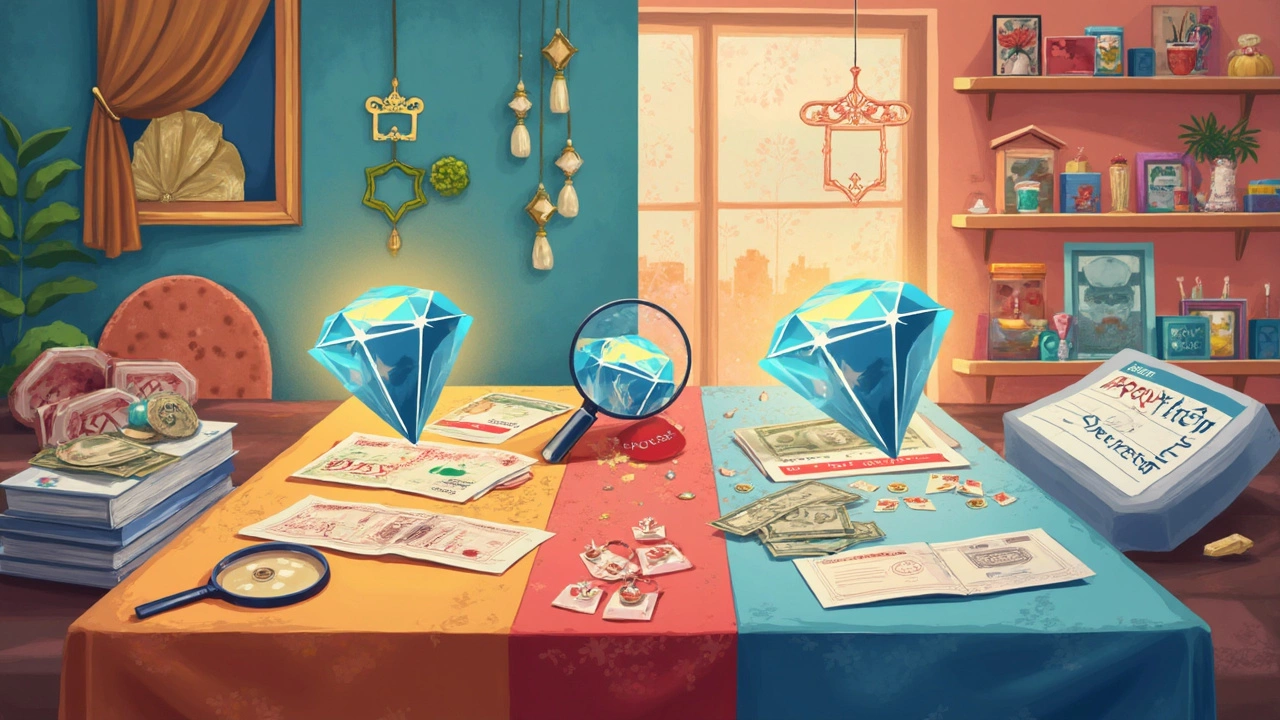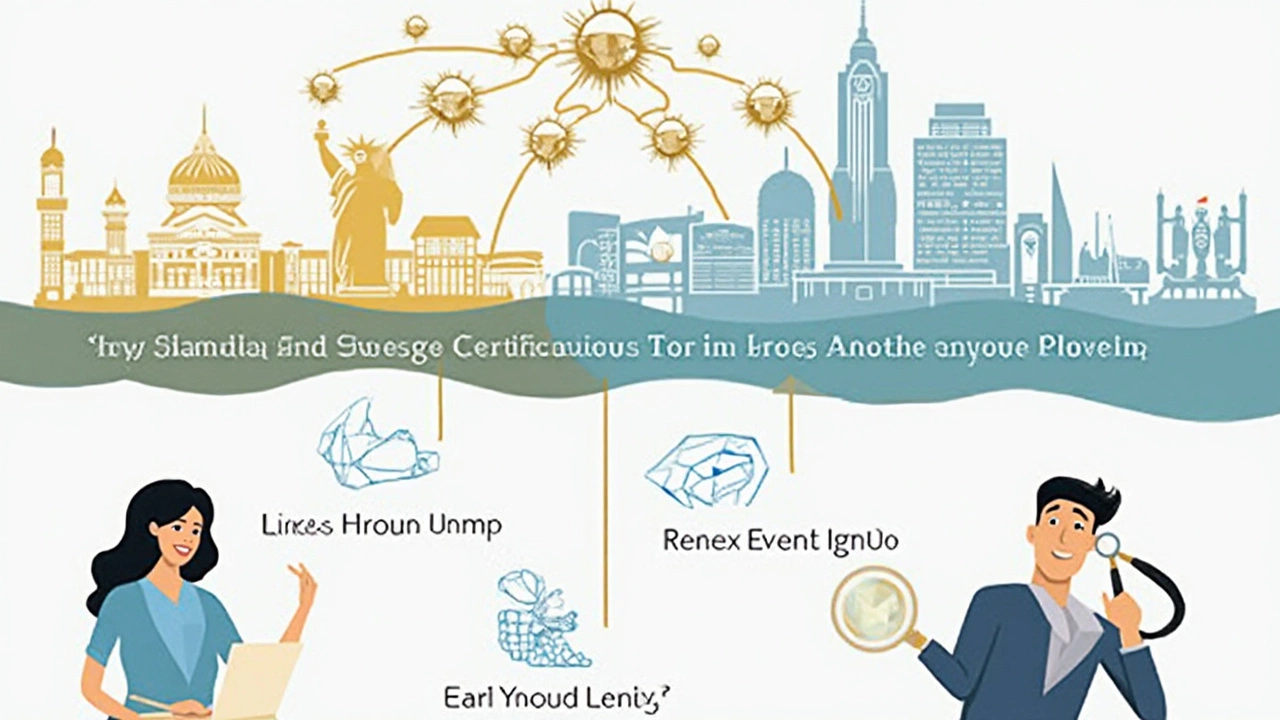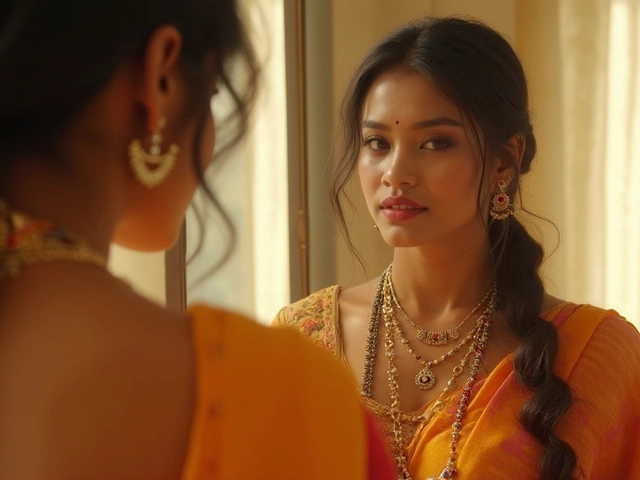
There’s a rumor that diamonds are a bargain in India compared to the USA, but it’s not that simple. If you’re trying to buy a diamond ring and care about getting real value, you have to look past the rumors and do some math.
Prices can look way lower in India at first glance. You might even see the same size and quality stone for up to 20-30% less than at a major retailer in the States. That sounds like a no-brainer, right? Not so fast. The tricky part is hidden fees, different grading systems, and sometimes, totally different standards for what's called “quality.” Let’s unpack what’s really happening so you don’t pay more than you need to—or accidentally buy something that’s worth a lot less than you think.
- Breaking Down Diamond Prices: India vs USA
- Why Diamonds Cost What They Do
- Taxes, Import Duties, and Hidden Costs
- Certification and Quality: What to Watch Out For
- Tips for Smart Diamond Shopping
Breaking Down Diamond Prices: India vs USA
Let’s get real about what you actually pay for a diamond ring in India compared to the USA. On paper, India is known as a hub for cutting and polishing diamonds, which means you’ll often see lower base prices there. In fact, big wholesalers in Mumbai and Surat supply diamonds to retailers all over the world—including a ton of stores in the States.
If you walk into a shop in India, you’ll probably notice that basic diamond prices (for loose stones, not rings) can be 10-30% lower than at a typical US jeweler. Sound tempting? It can be—but the price tag you see isn’t the whole story. For starters, US diamond prices almost always include sales tax and fees for grading by big labs like GIA or AGS, while in India, those costs are often extra.
Here’s a simple look at how prices stack up as of early 2025:
| Location | 1-Carat G VS2, GIA Certified | Extra Fees* |
|---|---|---|
| India (Mumbai) | $3,700 | 5% GST, Certification (~$100) |
| USA (New York) | $4,500 | Sales tax (6-9%), Often bundled certification |
*Estimates as of April 2025 — always double-check with local vendors.
India wins on wholesale diamond prices, but don’t forget: most tourists will get hit by GST (the Indian sales tax) and possibly export or conversion fees if they take the stone abroad. In the USA, the price for that same stone is higher, but it usually comes with a big-brand guarantee and tight consumer protections.
- India is cheaper if you’re buying loose stones right where they’re polished, especially if you can avoid middlemen.
- The USA usually bundles in certification and solid return policies. That peace of mind does have a price.
- For finished rings or branded settings, the price gap narrows—a ring in India isn’t always way cheaper once you pick a mount and pay taxes.
So, if you want the absolute rock-bottom price, fly to a city like Mumbai, work with a trusted diamond broker, and double-check every little fee. If you want less hassle and a straightforward return policy, the USA might be worth the extra spend.
Why Diamonds Cost What They Do
When you look at diamond prices in India and the USA, it’s not just about where you’re shopping—it’s the whole journey a diamond takes, from being dug out of the earth to landing in that fancy ring box. Price tags are built on a web of things you may not think about at first.
First, there are the world’s big diamond mining companies, most of them aren't even based in India or the USA. Rough stones usually come from places like Botswana, Russia, or Canada. Most diamonds are cut and polished in India because labor is cheaper, so naturally, factories and the massive diamond markets in cities like Surat push prices down locally. But that’s only part of the story.
The next factor is grading—how a diamond’s quality is judged. Diamonds get scored on the "4 Cs": carat, cut, color, and clarity. These are supposed to be universal, but a 1-carat VS1 diamond graded by a smaller Indian lab might not be the same as a 1-carat VS1 certified by GIA (the top US lab). This grading difference alone can swing the price by thousands of dollars.
Let’s talk about supply chains. In India, you skip a bunch of middlemen, so you see lower sticker prices. In the USA, most rings pass through importers, wholesalers, and retailers. Each one adds a markup. That’s why a diamond ring you see in New York could cost 30-40% more than a similar-looking ring in Mumbai.
Then there’s demand. Americans buy around half the world’s diamonds each year, and high demand keeps prices up. In India, people buy a lot of gold, but diamonds are catching up. Festivals and weddings spike local pricing at certain times, so even in the same city, you might see wild price swings in spring and during wedding season.
To give a better sense of the price gap, here’s a snapshot from a 2024 survey on retail prices for a 1-carat, GIA-certified, round brilliant diamond:
| Country | Average Price (USD) |
|---|---|
| USA | $6,500 |
| India | $5,200 |
Sure, India looks cheaper for that stone. But make sure you’re comparing apples to apples—same certification, same specs—because if you swap GIA for a local lab, or lower the cut quality, that $1,300 difference can disappear fast.

Taxes, Import Duties, and Hidden Costs
This is where your wallet starts to feel the pinch, even if a diamond looks cheap on paper. In India, the government hits all imported diamonds with hefty import duties, sometimes up to 7.5%. Then there’s GST—Goods and Services Tax—tacked on at 3% for diamond jewelry. Suddenly, that bargain starts shrinking fast.
In the US, the picture is different. Most diamonds are imported, but since so many dealers buy rough or polished gems in bulk, they get better rates and pay around 2.5% import duty. There’s no extra nationwide sales tax for everyone, but each state piles on its own tax, anywhere from 0% (like Oregon) to over 9% (hello, Tennessee). If you buy online from a retailer with no physical presence in your state, sometimes you dodge sales tax altogether—though that’s getting rarer as tax laws tighten.
| India | USA | |
|---|---|---|
| Import Duty | ~7.5% | ~2.5% |
| Local Sales Tax/GST | 3% GST | 0-9% (varies by state) |
| Hidden Fees | High (misc. charges, certification) | Lower, but some online fees apply |
But wait—there are more sneaky add-ons, like certification charges, making fees, and even "middleman" cuts if you’re not buying directly from a wholesaler. Many buyers in India get tripped up by these shady extras. In the US, things seem more straightforward, but watch for shipping, setting, and insurance fees, especially if you’re buying online.
- Always ask for a full breakdown of costs, including taxes and duties, no matter which country you’re buying from.
- If you’re flying back to the USA with a diamond from India, remember: US customs wants their share. You have to declare it, and you could get stuck paying duty.
- Never forget shipping, insurance, and conversion fees—they can really mess with your budget last-minute.
Certification and Quality: What to Watch Out For
When you’re sizing up diamond prices in India vs the USA, those certification papers can change everything. In the US, most jewelers deal in diamonds graded by GIA (Gemological Institute of America) or AGS (American Gem Society). These are the gold standard for reliable grading. In India, you’ll still find GIA stones, but there’s also IGI and even local labs that may be generous with their grading.
If your certificate isn’t from a big international lab, there’s a solid chance the quality is a little puffed up on paper. That VVS2 diamond might be more like an SI1 if the grading isn’t strict. Why does that matter? Because you could end up paying extra for a grade you’re not really getting. If you ever want to trade up or sell, US jewelers might only care about GIA or AGS paperwork.
- Always ask to see the certificate – and check the lab’s reputation online before you buy.
- If you’re scrolling listings on Indian sites, don’t just trust the grade; ask if it’s GIA-verified.
- Be careful with diamond rings that only come with a “local lab” certificate. These may not hold up when appraised in the US.
| Certification Lab | Common in India | Common in USA | Trust Level (Resale) |
|---|---|---|---|
| GIA | ✔ | ✔ | High |
| AGS | ✖ | ✔ | High |
| IGI | ✔ | ✔ | Medium |
| Local Labs | ✔ | ✖ | Low |
The upshot? That “cheap” diamond from India may save you cash upfront but could lose value fast if the certificate doesn’t match global standards. It’s always smart to consider certification type side-by-side with the price, especially for anyone buying a diamond ring in hopes that it’ll hold its worth in the long run.

Tips for Smart Diamond Shopping
If you’re serious about getting the most for your money, you can’t just compare price tags. There’s more to finding a solid deal on a diamond ring, whether you’re shopping in India, the USA, or online. Here’s what actually matters:
- Know the "Four Cs" cold. That’s cut, color, clarity, and carat. Cut usually has the biggest impact on price and sparkle. A slightly lower clarity or color that’s barely noticeable can save you thousands. Compare how these are graded in both countries—a GIA certificate from the US usually carries more weight globally.
- Don’t skip certification. Always demand a legit grading report—preferably from GIA, IGI, or HRD. In India, some local labs inflate grades, so double-check the paperwork or ask for international grading if you plan to ever resell.
- Understand taxes and duties. Diamonds in the USA have sales tax stacked on top of the sticker price. In India, there’s GST—currently 3% for polished diamonds—but also import duties, which affect imported brands. If you’re a tourist in India, you can sometimes claim GST refund at the airport before leaving, so keep those receipts.
- Bargain smarter in India. Most local jewelers expect negotiation. The first price isn’t the final price. It’s common (and totally acceptable) to ask for a 10–15% discount off the quote—sometimes more, especially if you’re paying in cash and skipping fancy packaging.
- Beware currency changes. The diamond prices you see change with the USD/INR exchange rate. If the rupee drops, prices can jump overnight.
Here’s a quick breakdown to show why the final cost can surprise you, even if the sticker price looks tempting:
| Cost Factor | India | USA |
|---|---|---|
| Retail Price | Lower | Higher |
| Certification | May vary (local/international) | Usually GIA/IGI |
| Taxes/Duties | GST 3% + import duty | Sales tax (avg. 5-10%) |
| Ability to Negotiate | High | Low |
The bottom line: don’t just chase the cheapest stone. Make sure it’s certified by a trustworthy lab and factor in every extra cost. For diamond rings india buyers, you can get more for your money—as long as you know the real quality and total price before you pay. No one wants to bring home a ring that’s worth less than they thought.



